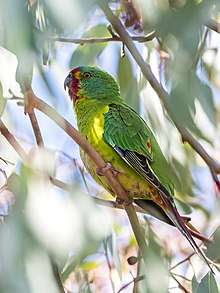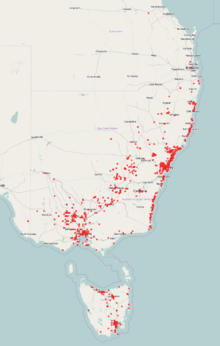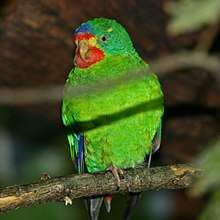Swift parrot
The swift parrot (Lathamus discolor) breeds in Tasmania and migrates north to south eastern Australia from Griffith-Warialda in New South Wales and west to Adelaide in the winter. It is related to the rosellas, with the feeding habits of a lorikeet. It is the only member in the genus Lathamus.
| Swift parrot | |
|---|---|
 | |
| A visiting migrant in Canberra, Australian Capital Territory | |
| Scientific classification | |
| Kingdom: | Animalia |
| Phylum: | Chordata |
| Class: | Aves |
| Order: | Psittaciformes |
| Family: | Psittaculidae |
| Genus: | Lathamus Lesson, 1830 |
| Species: | L. discolor |
| Binomial name | |
| Lathamus discolor (White, J., 1790) | |
 | |
| Distribution of the swift parrot From Atlas of Living Australia | |

There were estimated to be fewer than 2000 mature individuals remaining in the wild as of 2011.[2] In 2014, researchers from the Australian National University modelled that the species may face extinction by 2031 due to predation and loss of habitat,[3] the International Union for Conservation of Nature (IUCN) upgraded the status of the swift parrot from endangered to critically endangered in October 2015 based on results from the study.[1][4]
Taxonomy
The surgeon John White described the swift parrot in 1790 as the red-shouldered paroquet (Psittacus discolor).[5] It was placed in the genus Lathamus by René Primevère Lesson in 1830.
The swift parrot is only distantly related to the blue-winged and orange-bellied parrots, suggesting that two separate lineages might have become migratory.[6]
A 2011 genetic study including nuclear and mitochondrial DNA found that the swift parrot was an early offshoot from a lineage giving rise to the genera Prosopeia, Eunymphicus and Cyanoramphus, diverging around 14 million years ago. Its migratory status might have facilitated the spread of its relatives through the Pacific.[7]
Description
The swift parrot is about 25 cm (10 in) long and has long pointed wings and long tapering tail feathers. It is mainly green with bluish crown and red on the face above and below the beak. The adult female is slightly duller, and the juvenile has a dark brown iris and a pale orange bill.[8] The forehead to throat is crimson and there is also crimson patch at the top, edge of the wing. The female parrots are slightly duller than the males and with a creamy underwing bar. They are noisy, always active and showy, and are very fast with their direct flight. This parrots/species is also known as the Red-faced or Red-shouldered Parrot.
Breeding and social habits
The species breeds in Tasmania from September to December. It nests in tree hollows about 6–20 metres from ground level and usually with other breeding pairs. Eggs are white with 3–5 per clutch. Voice is of high pitched tinking chattering, piping pee-pit, pee-pit. They only breed from September to March.
Distribution
The swift parrot migrates across Bass Strait between Tasmania and the mainland of Australia. They arrive in Tasmania during September and return to south-eastern Australia during March and April.[9] They can be found as far north as south-eastern Queensland and as far west as Adelaide in South Australia, although recent sightings have been restricted to the south-eastern part of the state.
Important Bird Areas
BirdLife International has identified the following sites as being important for swift parrots:[10]
- New South Wales
- Brisbane Water
- Capertee Valley
- Hastings-Macleay
- Hunter Valley
- Lake Macquarie
- Richmond Woodlands
- South-west Slopes of NSW
- Tuggerah
- Ulladulla to Merimbula
- Victoria
- Bendigo Box-Ironbark Region
- Maryborough-Dunolly Box-Ironbark Region
- Puckapunyal
- Rushworth Box-Ironbark Region
- St Arnaud Box-Ironbark Region
- Warby-Chiltern Box-Ironbark Region
- Tasmania
Habitat
Usually inhabiting: forests, woodlands, agricultural land and plantations, and also in urban areas.
Diet
Seeds and grains, green vegetation, fruit, nectar and pollen, insects, grubs and larvae.
The presence of the winter-flowering golden wattle (Acacia pycnantha) is positively correlated with numbers of swift parrots overwintering in box–ironbark forest in central Victoria, while the presence of flowering eucalypts has no correlation.[11]
Conservation status
It is thought that only 1000 pairs remain in the wild. Habitat destruction and loss of old trees with nesting hollows are critical factors in its decline. Sugar gliders are the major predator of nesting parrots in mainland Tasmania, accounting for 85% of kills, but are absent from Bruny and Maria Islands.
Australia
Swift parrots are listed as endangered on the Australian Environment Protection and Biodiversity Conservation Act 1999.
State of Victoria, Australia
- The swift parrot is listed as threatened on the Victorian Flora and Fauna Guarantee Act (1988).[12] Under this Act, an Action Statement for the recovery and future management of this species has been prepared.[13]
- On the 2007 advisory list of threatened vertebrate fauna in Victoria, the swift parrot is listed as endangered.[14]
References
- Field guide to the birds of Australia Graham Pizzey and Frank Knight, Angus & Robertson 1997, 3rd edition 2000. ISBN 0-207-19714-8
- Forshaw, Joseph M. (2006). Parrots of the World; an Identification Guide. Illustrated by Frank Knight. Princeton University Press. ISBN 0-691-09251-6.
Footnotes
- BirdLife International (2015). "Lathamus discolor". IUCN Red List of Threatened Species. 2015. Retrieved 1 October 2015.CS1 maint: ref=harv (link)
- "Database for Swift Parrot Lathamus discolour". BirdLife International. BirdLife. Retrieved 4 April 2015.
- Stojanovic, Dejan (2 April 2015). "Let's stop Tasmania's swift parrots going the way of the dodo". The Conversation (Australia). The Conversation Media Group. Retrieved 4 April 2015.
- Jones, Kieran (30 October 2015). "Swift parrot listed as 'critically endangered' by conservation authority". ABC News. Australian Broadcasting Corporation. Retrieved 20 March 2016.
- White, John (1790). Journal of a Voyage to New South Wales with Sixty-five Plates of Non-descript Animals, Birds, Lizards, Serpents, Curious Cones of Trees and Other Natural Productions. Debrett. pp. 263.
- Joseph, Leo; Toon, Alicia; Schirtzinger, Erin E.; Wright, Timothy F. (2011). "Molecular systematics of two enigmatic genera Psittacella and Pezoporus illuminate the ecological radiation of Australo-Papuan parrots (Aves: Psittaciformes)". Molecular Phylogenetics and Evolution. 59 (3): 675–84. doi:10.1016/j.ympev.2011.03.017. PMID 21453777.
- Schweizer, Manuel; Güntert, Marcel; Hertwig, Stefan T. (2012). "Out of the Bassian province: historical biogeography of the Australasian platycercine parrots (Aves, Psittaciformes)". Zoologica Scripta. 42: 13–27. doi:10.1111/j.1463-6409.2012.00561.x.
- "Swift Parrot - BirdLife Species Factsheet". BirdLife International. 2008.
- Forshaw (2006). page 79.
- BirdLife International. (2011). Important Bird Areas. Downloaded from http://www.birdlife.org on 2012-01-02.
- Mac Nally, Ralph; Horrocks, Gregory (2000). "Landscape-scale conservation of an endangered migrant:the Swift Parrot (Lathamus discolor) in its winter range". Biological Conservation. 92 (3): 335–43. doi:10.1016/S0006-3207(99)00100-7.
- Department of Sustainability and Environment, Victoria Archived 2005-07-18 at the Wayback Machine
- Department of Sustainability and Environment, Victoria Archived 2006-09-11 at the Wayback Machine
- Victorian Department of Sustainability and Environment (2007). Advisory List of Threatened Vertebrate Fauna in Victoria - 2007. East Melbourne, Victoria: Department of Sustainability and Environment. p. 15. ISBN 978-1-74208-039-0.
| Wikimedia Commons has media related to Lathamus discolor. |
| Wikispecies has information related to Lathamus discolor |
